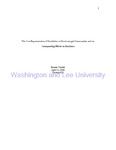The Over Representation of Disabilities in Disadvantaged Communities and the Corresponding Effects on Resilience

View/
Author
Vardell, E. Brooks
Subject
Washington and Lee University, Shepherd Poverty Program
Poverty
Learning disabilities
Learning disabled children
Special education
Education for All Handicapped Children Act (United States)
Learning disabilities -- Diagnosis
Intersectionality
Metadata
Show full item recordDescription
Capstone; [FULL-TEXT FREELY AVAILABLE ONLINE] E. Brooks Vardell is a member of the Class of 2010 of Washington and Lee University. The State of Learning Disabilities, 2009 stated that -- "Families below the poverty line reported that 4.1% of their children (ages 6-17) have learning disabilities. For families that were not poor, that figure was 2.7%. The same is true for adults in poverty, who self-reported their learning disabilities at twice the rate of adults who didn't live in poverty (3.1% vs. 1.5% for adults ages 18-64 and 1.2% vs. .6% for those age 65 or older)" (8). This over representation of learning disabilities in disadvantaged communities creates difficulty distinguishing a causal relationship. Did poverty create the disability or did the disability lead to the poverty? Either way, the connection remains unavoidable. This relationship also poses some difficulties that lead to my interest in the topic. If children living in poverty have a higher probability of having a learning disability, how do they receive the resources they need to succeed? Impoverished communities have fewer resources, poorer schools, and less of a chance at diagnosing the disability let alone providing the necessary resources to promote an environment for a disabled individual to succeed to maximum potential. [From introductory section] Brooks Vardell